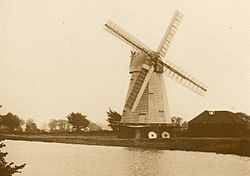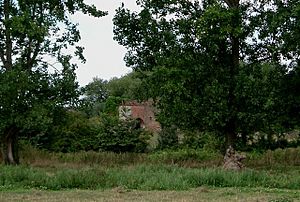South Ockendon Windmill facts for kids
Quick facts for kids South Ockendon Mill |
|
|---|---|

The mill in working order c1900
|
|
| Origin | |
| Mill name | South Ockendon Mill |
| Mill location | TQ 604,831 |
| Coordinates | 51°31′26″N 0°18′40″E / 51.524°N 0.311°E |
| Operator(s) | Private |
| Year built | 1820s |
| Information | |
| Purpose | Corn mill |
| Type | Smock mill |
| Storeys | Three-storey smock |
| Base storeys | Two-storey base |
| Smock sides | Eight-sided smock |
| No. of sails | Four sails |
| Type of sails | Patent sails |
| Windshaft | Cast iron |
| Winding | Fantail |
| Fantail blades | Eight blades |
| Auxiliary power | Steam Engine |
| No. of pairs of millstones | Three pairs, |
| Year lost | 1977 |
| Other information | A waterwheel drove one pair of millstones independent of the windmill |
The South Ockendon Windmill was a special type of Smock mill located in South Ockendon, England. It was a tall, wooden windmill that sadly fell down on November 2, 1977. Windmills like this one were very important long ago for grinding grain into flour.
Contents
History of South Ockendon Mill
The South Ockendon Windmill was built in the 1820s. Some records say it was built in 1829, but it appeared on a map from 1825. This mill was quite unique because it was a "combined mill." This means it used two different ways to power its grinding stones: wind and water! A waterwheel in its base helped to grind grain, working alongside the wind-powered parts.
The waterwheel might have been part of the mill from the very beginning. We know for sure it was there by 1845. In June 1853, the mill was hit by lightning, which must have been quite a sight!
Later, by 1912, a steam engine was added to help with the grinding. The mill stopped working completely in 1923. Then, on November 2, 1977, the old windmill collapsed.
After it fell, some of its parts were saved and stored by an expert named Vincent Pargeter. There was a plan in 1994 to put some of these parts on display in South Ockendon, but it didn't happen. The pieces are still kept safe, just in case someone decides to build a new version of the mill someday. In 2005, some of the old machinery was even used to help fix another windmill in Halvergate, Norfolk.
How the Windmill Looked
The South Ockendon Windmill was a "three-storey smock mill" sitting on a "two-storey brick base." Imagine a tall, wooden tower that looks a bit like a person wearing a smock (a loose shirt), placed on top of a strong brick building. It had a platform around the first floor.
This windmill had four large sails. Two of these were "double Patent sails," and two were "single Patent sails." These special sails could adjust themselves automatically to catch the wind. The top part of the mill, called the cap, was shaped like a boat. It could turn to face the wind thanks to a special tail-like part called a fantail.
Mill Structure and Size
The base of the South Ockendon Windmill was made of brick and had eight sides, like an octagon. This base had two levels: the ground floor of the mill and a cellar underneath. It was about 26 feet 4 inches (8.03 m) wide and 8 feet 4 inches (2.54 m) tall. The cellar was almost 8 feet (2,438 mm) high.
The entire windmill stood very tall, about 58 feet (17.68 m) from the ground to the very top of its cap. The wooden "smock" part was about 30 feet 6 inches (9.30 m) tall by itself. At its widest point at the top, the smock was about 16 feet 2 inches (4.93 m) across. The platform around the mill was about 8 feet 4 inches (2.54 m) above the ground.
The cap, which was the very top part that held the sails, looked like a boat. An eight-bladed fantail helped the cap turn to keep the sails facing the wind.
Sails and Windshaft
The South Ockendon Windmill had a strong cast-iron shaft, called a windshaft, that held the sails. It had two double Patent sails and two single Patent sails. When fully spread out, the sails were about 64 feet (19.51 m) wide! The double sails had eleven sections, each with three shutters. The single sails had nine sections, also with three shutters. These shutters would open and close to control how much wind the sails caught.
Inside the Machinery
Inside the mill, a large wooden "brake wheel" was about 9 feet 2 inches (2.79 m) wide. This wheel was connected to a cast-iron center with six arms. It helped to control the speed of the mill. A wooden "wallower" and a tall "Upright Shaft" transferred power down from the brake wheel. The Upright Shaft was made from four pieces of wood.
At the bottom, a large wooden "Great Spur Wheel" turned three pairs of grinding stones, called millstones. These millstones were made of French Burr stone. Two pairs were about 4 feet (1.22 m) wide, and the third pair was about 4 feet 10 inches (1.47 m) wide. These stones ground the grain into flour.
Remember the waterwheel? It was an "undershot" type, meaning the water flowed under it to make it turn. This waterwheel powered a fourth pair of millstones on the first floor, separate from the wind-powered ones.
How the Fantail Worked
The South Ockendon Windmill used an eight-bladed fantail to make sure its sails always faced the wind. This fantail turned a wooden "worm gear" which then moved cogs at the top of the smock, slowly turning the cap and sails into the best position for the wind.
Millers
These are some of the people who worked as millers at South Ockendon Windmill:
- William Eve (1820 – 1829)
- Thomas Banks (1845)
- Thomas Bennett Sturgeon (1848)
- Stephen Challis (1877)
- Smith (around 1877 – 1919)
- C and William Sturgeon (1912 – 1914)


